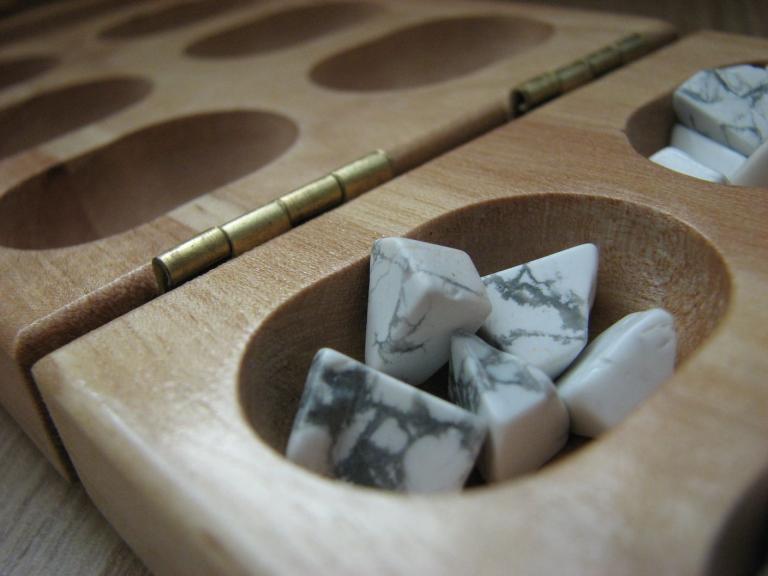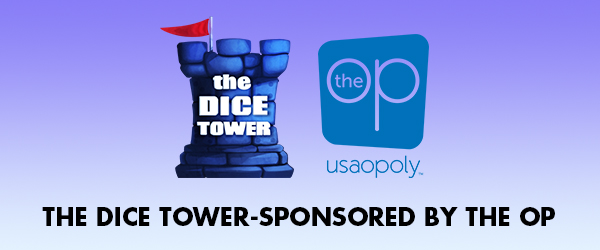Kalah

Kalah
The most common rule set in games sold commercially as Mancala is for this game of Kalah.
Mancala is actually a whole family of games.
Kalah was invented in 1940 by an American, William Champion Jr.. He started selling the game in 1944, patented the rules in the 1950's, and founded the Kalah Game Co. in 1958.
The game is played on a board of two rows, each consisting of six round pits. The rows have a large store at either end called the Kalah.
A player owns the six pits closest to them and the Kalah on their right side.
The game is started with four (4) seeds in each pit.
A player takes all the seeds from one of their pits, and then they are distributed one by one, counterclockwise, in the pits and the player's own Kalah, but not into the opponent's store (Kalah).
If the last seed is dropped into an opponent's pit or a non-empty pit of the player, the move ends without anything being captured.
If the last seed falls into the player's Kalah, they must move again.
If the last seed is put into an empty pit owned by the player, they capture all contents of the opposite pit together with the capturing piece and puts them in their Kalah. If the opposite pit is empty, nothing is captured. A capture ends the move.
The game ends when one player no longer has any seeds in any of their holes. The remaining pieces are captured by their adversary. The player who has captured the most pieces is declared the winner.
Variants:
Beginners may start with 3 seeds in each pit, but the game can also be played with 5 or 6 seeds in each pit. William Champion Jr. recommended the expert game with 6 in each pit.
Mancala is actually a whole family of games.
Kalah was invented in 1940 by an American, William Champion Jr.. He started selling the game in 1944, patented the rules in the 1950's, and founded the Kalah Game Co. in 1958.
The game is played on a board of two rows, each consisting of six round pits. The rows have a large store at either end called the Kalah.
A player owns the six pits closest to them and the Kalah on their right side.
The game is started with four (4) seeds in each pit.
A player takes all the seeds from one of their pits, and then they are distributed one by one, counterclockwise, in the pits and the player's own Kalah, but not into the opponent's store (Kalah).
If the last seed is dropped into an opponent's pit or a non-empty pit of the player, the move ends without anything being captured.
If the last seed falls into the player's Kalah, they must move again.
If the last seed is put into an empty pit owned by the player, they capture all contents of the opposite pit together with the capturing piece and puts them in their Kalah. If the opposite pit is empty, nothing is captured. A capture ends the move.
The game ends when one player no longer has any seeds in any of their holes. The remaining pieces are captured by their adversary. The player who has captured the most pieces is declared the winner.
Variants:
Beginners may start with 3 seeds in each pit, but the game can also be played with 5 or 6 seeds in each pit. William Champion Jr. recommended the expert game with 6 in each pit.
Player Count
2
Playing Time
10
Age
5
Year Released
700
Designers
William Julius Champion Jr.
Publishers
WWF, Worldwide Games, Inc., Woodstock Spiele, Wood Expressions, Whitman Golden Ltd., VEB Plastspielwaren Berlin, University Games, Top-Toy, Top-Game, On Target Games, Tactic, Starbucks Coffee Company, Square Root Games, SPM: Syarikat Permainan Malaysia, Spear's Games, Skor-Mor, Science4You, Schylling, Schmidt Spiele, RCR Terry GmbH, Ramsons, Queen Games, Profound, Pressman Toy Corp., Plastolus Szarvas, Plasticart, Planet Finska, Pin International, Piet Hein A/S, PICO PAO / Juegos de la Antigüedad, Philos, Pelikan, Pavilion, Parker Brothers, Origem, Oficina do Aprendiz, Natural Wonders, Müller Ltd. & Co. KG, Monkey Pod Games, Mitra, Melissa & Doug, Maplegrove, Ludens Spirit, Learningsmith, Lazy Days (I), Lagoon Games, L. P. Septímio, Kontrell Industries, King International, Jumbo, Juguetes del Puerto, Trefl Joker Line, Joen, Intermón Oxfam, IKEA, Holzinsel, Great American Trading Company, GoKids 玩樂小子, Gerd Koch, Geoludie, Games & Graphics Inc., Fundex, Fame Products, Estrela, Endless Games (I), Elven Games, E.S. Lowe, Dujardin, Domino-Verlag, Dilemma Games, DeAgostini, danspil, Daddy-O Productions, Cylinder Games, Creative Crafthouse, Classic Games, CHH Games, Cayro, the games, Carrom Art, Cardinal, The Canadian Group, Brookstone, Brio AB, Brain Games Germany, Bohemia, Barnes & Noble, ASS Altenburger Spielkarten, Alga, Adrenaline Brush Ltd, Luchacabra, (Unknown), (Public Domain)
Board Game Category
Abstract Strategy
Podcasts Featuring this Game

TDT # 392 - Best Dice in Board Games
In this show, we talk about Empire Engine, Artificium, Kings of Israel, Robot Turtles, Cthulhu Wars, Hyperborea, Pints of Blood, and Dogs of War. We have a tale of horror and of amazement, Mark talks about his kids, Mary about Tichu strategy, and Brian about Mancala. Tom discusses why the Dice Tower is about games, but especially the people who play them; and we end the show with our favorite dice found in games.